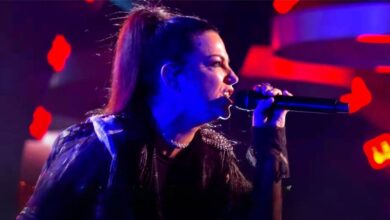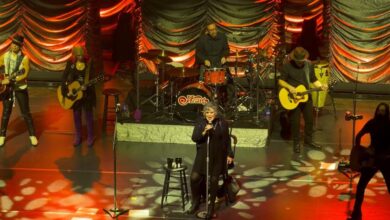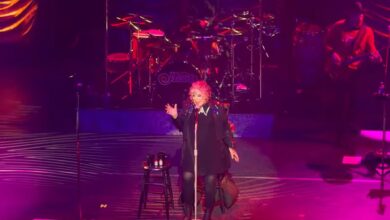Listen : This is the unrivaled number one Christmas song, unmatched by any other.
“Fairytale of New York” by The Pogues, featuring Kirsty MacColl, has become an enduring classic, captivating listeners with its unique blend of melancholy, romance, and gritty realism that sets it apart from traditional holiday songs. Released in 1987, this song narrates the tale of a failed relationship set against the backdrop of Christmas in New York. Its raw lyrics and unfiltered portrayal of love and loss resonate with listeners who find beauty in its unconventional approach to holiday themes.
The song opens with a nostalgic melody from a lone piano, drawing the listener into the scene as Shane MacGowan’s gravelly voice sets a somber tone. MacGowan’s vocals introduce a narrative that reflects his character’s disillusionment, contrasting sharply with the joyful sound that traditionally accompanies Christmas music. This contrast is intensified when Kirsty MacColl joins, her voice bringing a hopeful yet confrontational energy as she and MacGowan exchange lines, creating a dialogue filled with regret, longing, and unresolved tension. This dynamic contributes to the song’s impact, highlighting the tension between hope and despair.
One reason “Fairytale of New York” remains a favorite is its authentic storytelling. It delves into the complex emotions of its characters, moving away from the idealized, often sanitized version of Christmas that dominates the genre. The characters struggle with addiction, financial hardship, and lost dreams—topics seldom addressed in holiday songs. This realism gives the song depth, appealing to those who see Christmas as a time for reflection, even for revisiting past hardships. The song’s storytelling aligns with classic Irish folk traditions, where tales of love and loss are shared openly, even against the warmth of festive cheer.
The chorus, with its refrain of “The boys of the NYPD choir were singing ‘Galway Bay,’” transports listeners to a scene that feels both real and cinematic. This line exemplifies the song’s ability to blend fantasy with reality, creating an image of New York City that’s both mythical and grounded. The NYPD choir does not actually sing “Galway Bay,” yet this lyrical liberty paints a vivid picture in the listener’s mind, symbolizing the dreamlike nature of memory and the way people romanticize the past. This chorus has a chant-like quality, drawing audiences in and encouraging them to sing along, making it a memorable holiday anthem.
Watch the video below :
Another striking feature is the music itself, which draws from both Irish folk and rock influences. The instrumental interludes, featuring accordions and tin whistles, give the song a traditional Irish sound that evokes nostalgia for simpler times. Yet, the production has a gritty edge, adding to the song’s authenticity and reinforcing its message. This blend of musical styles captures the energy of New York while maintaining the roots of The Pogues’ Irish heritage, symbolizing the immigrant experience and the sense of longing that often accompanies it.
The song’s popularity and staying power are also attributed to its defiance of convention. In an era where holiday music is often cheerful and saccharine, “Fairytale of New York” stands out by embracing life’s darker realities. It has sparked debates and controversies over the years, particularly around its language and themes. Despite occasional backlash, the song has largely maintained its original lyrics, suggesting that listeners appreciate its unfiltered honesty. This defiance adds to its mystique, giving it an edge that few Christmas songs possess.
The impact of “Fairytale of New York” on pop culture is undeniable. It has been covered by numerous artists across various genres, from Ed Sheeran to Florence and the Machine, each bringing their interpretation while preserving the song’s essence. These covers, though, often emphasize how distinctive and irreplaceable the original version is. The song’s influence has extended beyond music, inspiring holiday episodes in TV shows and references in films, solidifying its place in the cultural landscape.
In Ireland and the UK, the song’s legacy is particularly strong. It consistently ranks among the most popular Christmas songs in these regions, sometimes even topping holiday charts decades after its release. “Fairytale of New York” has become a holiday tradition in itself, a song that marks the season for many people. It has a communal feel, with audiences gathering each year to sing it together, its themes of hardship and resilience resonating especially during the winter season.
Shane MacGowan and Kirsty MacColl’s performances play a crucial role in the song’s success. Their voices contrast yet complement each other, bringing life to the characters they portray. MacGowan’s raw, rough-edged delivery perfectly embodies his character’s regret, while MacColl’s voice adds strength and vulnerability. This vocal interplay elevates the song beyond a simple duet; it feels like a mini-drama set to music, a story that unfolds with each verse and chorus.
Ultimately, “Fairytale of New York” captures the spirit of Christmas in a way that few other songs do, balancing hope and heartbreak, warmth and bitterness. It reflects the complexity of the holiday season, acknowledging that for many, it’s a time of reflection as much as celebration. This emotional depth is why the song has resonated for generations and why it continues to be celebrated as one of the greatest Christmas songs ever made.





